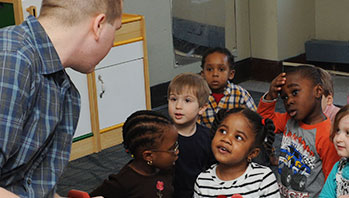- paint squares (various shades of skin colors)
- magazine pictures (children of different ethnic groups/varying shades of skin color)
- color
- dark
- darker
- lighter
- shade
MA Standards:
Speaking and Listening/SL.PK.MA.1: Participate in collaborative conversations with diverse partners during daily routines and play.
Language/L.PK.MA.1: Demonstrate use of oral language in informal everyday activities.
Language/L.PK.MA.6: Use words and phrases acquired through conversations, listening to books read aloud, activities, and play.
Head Start Outcomes:
Language Development/Receptive Language: Attends to language during conversations, songs, stories, or other learning experiences.
Language Development/Expressive Language: Uses language to express ideas and needs.
Language Development/Expressive Language: Uses increasingly complex and varied vocabulary.
Social Emotional Development/Self-Concept and Self-Efficacy: Identifies personal characteristics, preferences, thoughts, and feelings.
PreK Learning Guidelines:
English Language Arts/Language 2: Participate actively in discussions, listen to the ideas of others, and ask and answer relevant questions.
English Language Arts/Language 3: Communicate personal experiences or interests.
Talk Together: Skin Colors

© Commonwealth of Massachusetts, Department of Early Education and Care (Jennifer Waddell photographer). All rights reserved.
STEM Key Concepts: There are many different colors; A color can have many different shades (from very light to very dark); There are many shades of skin color
ELA Focus Skills: Compare Colors, Follow Directions, Speaking and Listening, Vocabulary
Educator Prep: If you are unable to find paint square at a hardware or paint supply store, prepare paint squares of varying “skin tone” colors.
Talk about how people look the same in some ways and different in other ways. For example say,
- I have <very dark> hair. Stand up if you have very dark hair like mine. <Tasha> has very dark hair, so that is one way we are similar, or the same.
- Stand up next to <Tasha> and say, I am tall and Tasha is short. So, that is one way we are different.
- Steer children to talk about observable similarities and differences.
Display the magazine pictures. Ask, Can you tell me some ways these children are the same? Guide children to respond that they are all children, they all have a nose and two eyes, etc. Ask, How are they different? Direct discussion to include skin tones. Say, Even though the children are similar, they have different shades of skin color. Point to a very light-skinned girl in a picture. Then point to a picture of a boy who is darker and say, This boy’s skin is darker than this girl’s skin.
- Provide color paint squares in various shades of tan, brown, and cream. Spread them out so children can see the variety and talk about them. Say, People have many different skin tones, or colors of skin. Which color is most like the color of your skin?
Social Emotional Tip: Remind children of Quack from the show PEEP and the Big Wide World “A Peep of a Different Color” and how he was proud of his color. Discuss how their skin color distinguishes them as individuals.
English Language Learners: If young children have difficulty distinguishing similarities and differences, show them two blocks, one red and one green, and have them finish the language frames: These are alike: they are similar because they are both blocks. But they are different because one is green and one is red. Continue with other examples.
